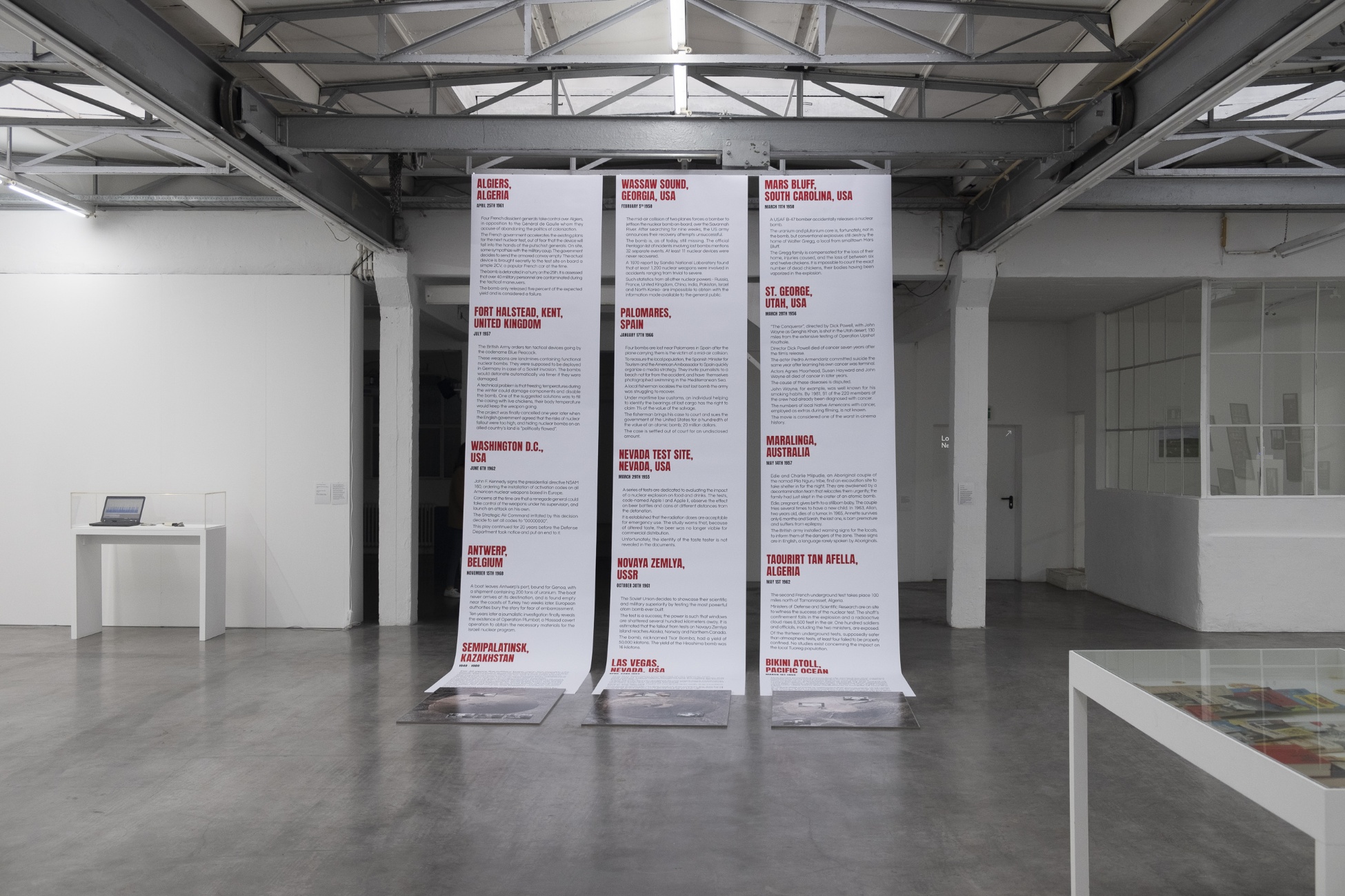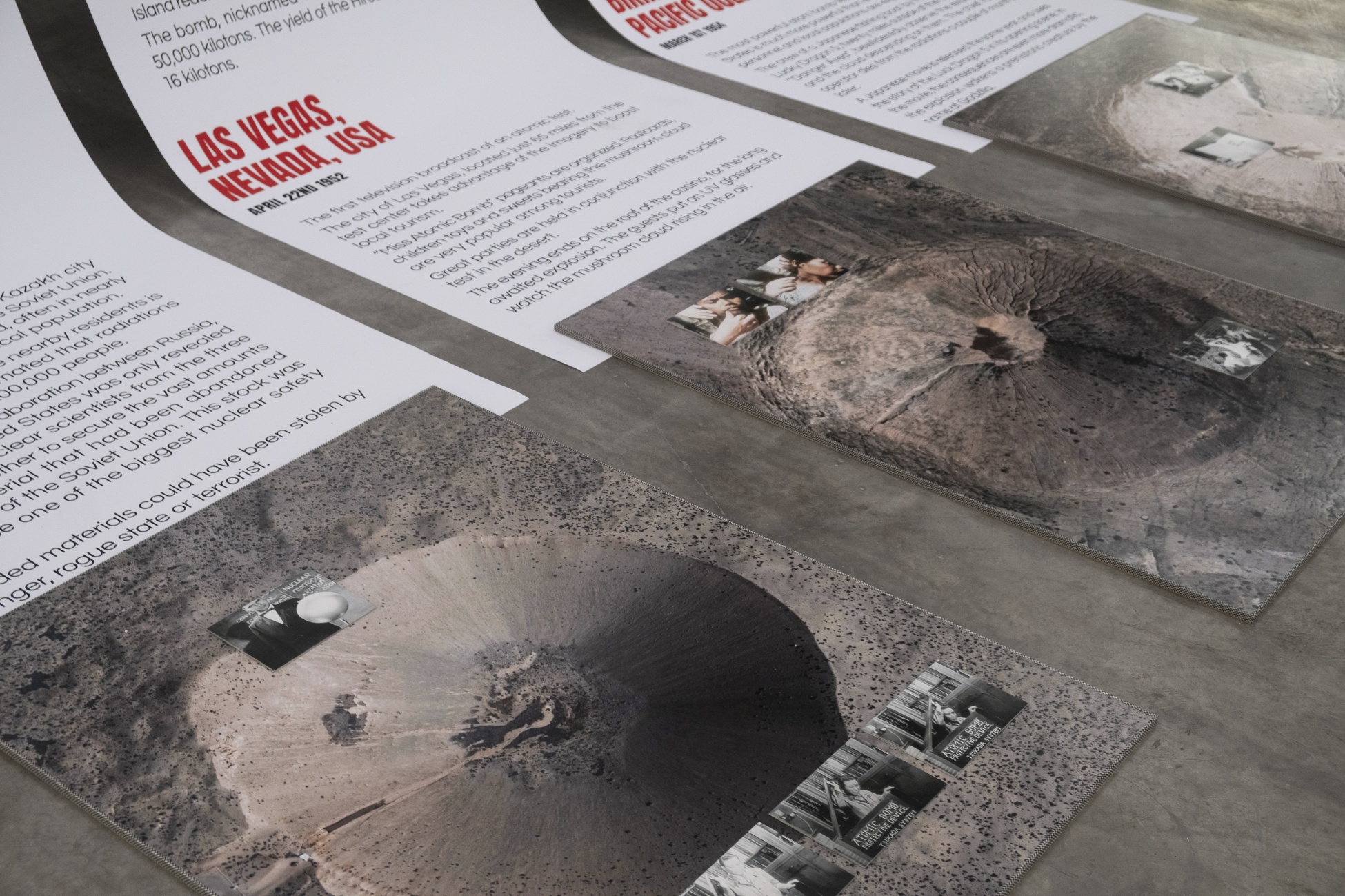← back
Anecdotal
In our collective unconscious the nuclear age is synonymous with the explosion of two atom bombs. Hiroshima and Nagasaki. But since 1945 more than 2000 nuclear bombs have been detonated on Earth. For fear of being attacked by foreign nations, nuclear power countries have instead methodically bombed their own lands.
Self mutilation in the name of self defense.
This series' starting point is the unfamiliar stories and anecdotes around nuclear armament and testing programs. Archival photos, satellite imagery, packshots and road-trip photos are mixed recontextualize a history wavering between horrific investigation and absurd farce.
All that is documented here is true, but seems to be from a work of bad fiction. These are the stories of contaminated ministers, bombs lost and never found, the invention of the bikini, the struggles between colonial powers and local populations, and even vaporized chickens.
Illustrating and playing around with these unfamiliar narratives shines a new light on the dissonance between the world we believe we live in and the one we have actually built.

Munich, 2019

Munich, 2019
Wassaw Sound, Georgia, USA
February 5, 1958
The mid-air collision of two planes forces a bomber to jettison the nuclear bomb on-board, over the Savannah River.
After searching for nine weeks, the US army announces their recovery attempts unsuccessful.
The bomb is, as of today, still missing.
The official Pentagon list of incidents involving lost bombs mentions 32 separate events. At least 11 nuclear devices were never recovered.
A 1970 report by Sandia National Laboratory found that at least 1200 nuclear weapons were involved in accidents ranging from trivial to severe.
Such statistics from all other nuclear power countries, Russia, France, United Kingdom, China, India, Pakistan, Israel and North Korea, are at the time impossible to obtain with the information made available to the general public.
31.936597° N, 80.948197° W




Bikini Atoll, Marshall Island
March 1, 1954
The most powerful atom bomb tested by the United States is much more powerful than expected. Military personnel and local populations are exposed.
The crew of a Japanese fishing boat by the name of Lucky Dragon 5, 20 miles outside of the declared "Danger Area" , bewilderedly observe the explosion and the cloud descending on them. The chief radio operator dies from the radiations a couple of months later.
A Japanese movie is released the same year, and uses the story of the Luck Dragon 5 in its opening scene. In the movie, the consequences are even more dramatic, the explosion wakens a prehistoric creature by the name of Godzilla.
11.558947° N, 165.387383° W
Palomares, Spain
January 17, 1966
Four bombs are lost near Palomares in Spain after the plane carrying them is the victim of a midair collision.
To reassure the local population, the Spanish Minister for Tourism and the American Ambassador to Spain quickly organize a media strategy. They invite journalists to a beach not far from the accident, and have themselves photographed swimming in the Mediterranean Sea.
A local fisherman localizes the last lost bomb the army was struggling to recover. Under maritime law customs, an individual helping to identify the bearings of lost cargo, has the right to claim 1% of the value of the salvage.
The fisherman brings his case to court, and sues the government of the United States for a hundredth of the value of an atomic bomb; 20 million dollars.
The case is settled out of court for an undisclosed amount.
37.235933° N, -1.778673° W




Mars Bluff, South Carolina, USA
March 11, 1958
A USAF B-47 bomber accidentally releases a nuclear bomb.
The uranium and plutonium core is, fortunately, not in the bomb, but conventional explosives still destroy the home of Walter Gregg, a local from small-town Mars Bluff.
The Gregg family is compensated for the loss of their home, injuries caused, and the loss of between six and twelve chickens. It is impossible to count the exact number of dead chickens, their bodies having been vaporized in the explosion.
34.200938° N, -79.657151° W
Nevada Test Site, USA
March 29, 1955 & May 5, 1955
A series of tests are dedicated to evaluating the impact of a nuclear explosion on food and drinks. The tests, code-named Apple I and Apple II, observe the effect on beer bottles and cans at different distances from the detonation.
It is established that the radiation doses are acceptable for emergency use. The study warns that, because of altered taste, the beer was no longer viable for commercial distribution.
Unfortunately, the identity of the taste-tester is not revealed in the documents.
37.099450° N, -116.048560° W























